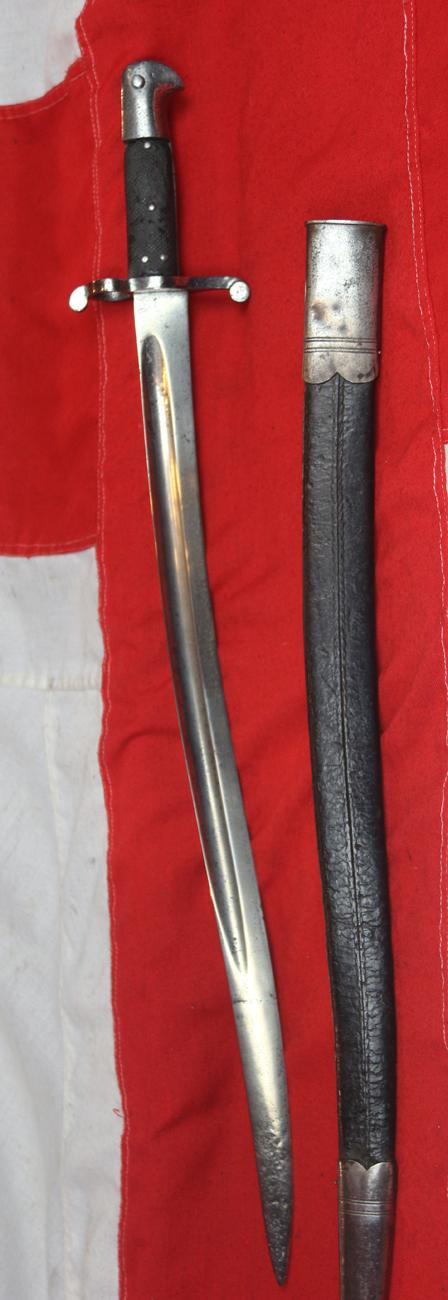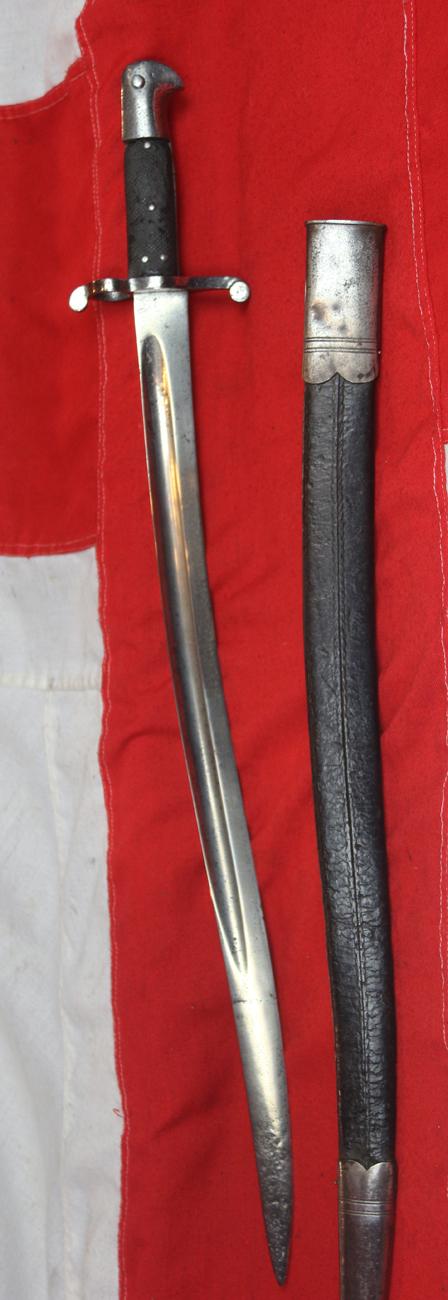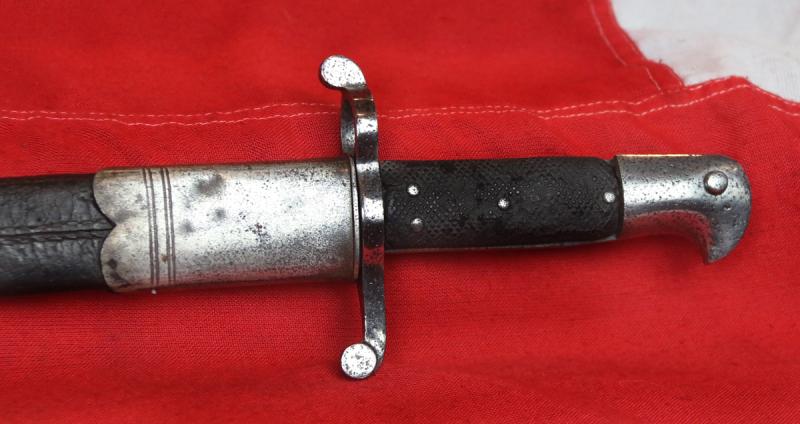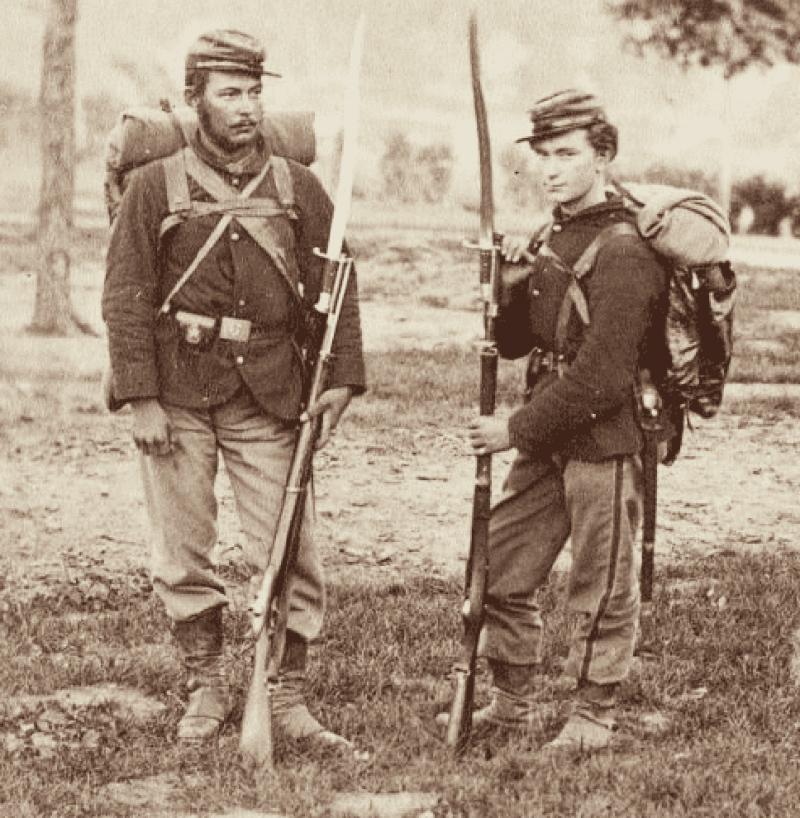A Superb Service Issue 1856-8 Two Band Enfield Yataghan Blade Sword Bayonet. Used In The Opium War with the P1853 Enfields in The Late 1850's China and the American Civil War From 1861
The rifle that this sword bayonet was designed for the P1853 two band Enfield rifle, and was the type used in the late Indian Mutiny at the "Seige and Relief of Lucknow". Chequered leather grip with rivets, and screw affixed retaining spring. Good, long, Yataghan blade in bright polish. Excellent leather. The regiments that used this bayonet sword took part in the Second Opium War, the Indian Mutiny and the Third Anglo-Burmese War, and tens of thousands of service issue rifles and bayonets were sold to America in the Civil war, purchased by both the North, and the South. See photos in the gallery of Union and Confederates with the Enfield rifles and their yataghan bayonets. After the Civil War thousands of Confederate purchased Enfields were sold to Japan's Tokugawa Shogunate, and used in the Boshin war and the Satsuma Rebellion.
A quote from a Confederate officer's diary,
"Every short two-band Enfield which came into possession of any of our men was taken away and given to these men sharpshooters ... But there were not enough and some of them had the common long Enfield."
It would appear that by mid-war in the Confederate Service, while the infantry was provided with the longer rifle-muskets where possible, the shorter rifles (US or Enfield) were preferred for use by the Cavalry:
Gen. Basil Duke noted of Morgan's Cavalry, they did not even like the American shorter carbine length muzzle loaders (musketoons):
"Morgan's Cavalry in the west preferred the British arm they called the "medium Enfield" the two band rifle. The short Enfield carbine they found convenient to carry, but deficient in range and accuracy. The long-Enfield (three band) they found inconvenient to carry, and difficult to use (as was sometimes necessary) on horseback. Regardless, in that command one company had the long Enfield, another the short, and another the medium.
We bought the entire small collection from the widow of a 'Best of British Empire Rifles and Bayonets, Both British and German' collector, who acquired them over the past 40 years, and only ever kept the very best he could afford to keep. Act fast they are selling really fast, three rifles and eight bayonets and a cutlass have sold in two days alone. Top quality and condition,19th and 20th century scarce British and German collectables are always the most desirable of all.
The Confederates imported more Enfields during the course of the war than any other small arm, buying from private contractors and gun runners and smuggling them into Southern ports through blockade running. It has been estimated that over 900,000 P53 Enfields were imported into America and saw service in every major engagement from the Battle of Shiloh (April 1862) and the Siege of Vicksburg (May 1863), to the final battles of 1865. The gun was highly sought after in the Confederate ranks. According to a survey taken by British officials during the early stages of war on the arms of the Western Confederate Forces, nearly 70% were armed with smoothbore arms, such as the Model 1842 Springfield. Later in the war the same survey was taken, they found that more than 75% had acquired a rifle, mainly the Pattern 1853 Enfield.
The P53 Enfields capabilities were largely lost by the lack of marksmanship training by both the Union and Confederacy. Most soldiers were not trained to estimate ranges or to properly adjust their sights to account for the "rainbow-like" trajectory of the large calibre conical projectile. Unlike their British counterparts who attended extensive musketry training, new Civil War soldiers seldom fired a single cartridge until their first engagement. After the end of the war, hundreds of formerly Confederate Enfield 1853 muskets were sold from the American arms market to the Tokugawa shogunate, as well as some prominent Japanese domains including Aizu and Satsuma. These units were later used in the Boshin War, and some remaining in Satsuma were also used by rebelling former samurai in the Satsuma Rebellion about a decade later.
Code: 25154










